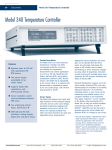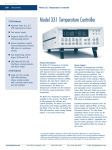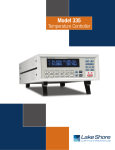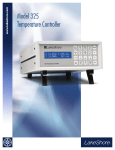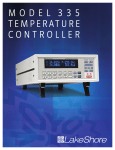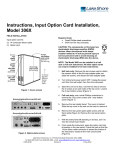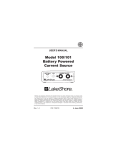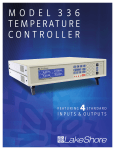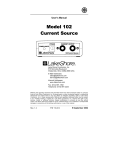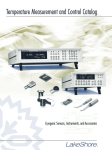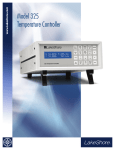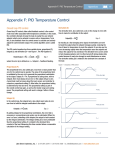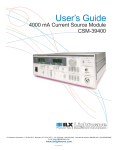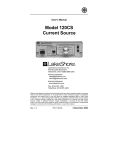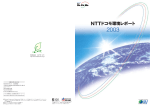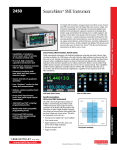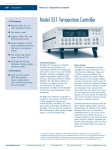Download MODEL 350 TEMPERATURE CONTROLLER
Transcript
www.lakeshore.com MODEL 350 U LT R A - LO W C R YO G E N I C T E M P E R AT U R E CONTROLLER Ideal for use with He-3 systems and other ultra-low temperature refrigeration platforms down to 100 mK O P T I M I Z E D C E R N O X ™ PERFORMANCE Model 350 Ultra-Low Cryogenic Temperature Controller Ideal for use with He-3 systems and other ultra-low temperature refrigeration platforms down to 100 mK Optimized performance with Cernox™ RTDs Patented low-noise input circuitry enables super low excitation power for minimal self-heating and high resolution measurement 4 independent control loops and a broad range of I/O configurations can eliminate need for additional instrumentation 4 PID-controlled outputs: 75 W warm-up heater, 1 W sample heater, and 2 auxiliary 1 W ±10 V outputs Proven, intuitive interface Performance assurance even at the extremes, with verifiable product specifications Full 3 year standard warranty A Powerful Ultra-Low Temperature Physics Tool The Model 350 is designed for the demands of pumped He-3 refrigerators and other ultra-low and low temperature platforms. It provides excellent measurement performance, superior control accuracy, and convenient operation in a wide range of advanced research applications. Whether the need is for high accuracy with minimal thermal impact, or precise temperature control in high magnetic fields, or dependable measurement in radiation environments, the new Model 350 controller matched with Lake Shore’s industry-leading Cernox™ sensors provides a cryogenic solution that’s demonstrably best-in-class. In short, the Model 350 cryogenic temperature controller brings a new level of power, precision, and performance to critical low temperature physics research. It is ideal for use with He-3 systems, adiabatic demagnetization refrigerators (ADRs), certain dilution refrigerators, and many other applications demanding low thermal power and high measurement precision. Application Versatility Designed to support a broad range of sensor types, the Model 350 is performanceoptimized for use over the entire temperature The patented noise reduction input circuitry range of Cernox™ sensors, making it the of the Model 350 is just one reason why instrument of choice for ULT environments as this controller works so well for ultra-low well as other cryogenic systems where errors temperature (ULT) applications, all the way due to magneto-resistive or radiation effects down to 100 mK. When combined with precision need to be minimized. Cernox sensors, this performance-optimized design allows as little as 10 nA of excitation 4 standard sensor input channels current to be used, minimizing self-heating effects, and ensures best possible measurement The Model 350 comes with four standard sensor inputs supporting Cernox™, ruthenium accuracy throughout the entire temperature oxide, platinum RTDs, and other NTC RTD range. sensors. Inputs can be configured to accept any of the supported input types. Each This single instrument offers extraordinary sensor input channel has its own current capability and flexibility, often eliminating source, providing fast settling times. The the need for additional instrumentation in four sensor inputs are optically isolated from a refrigeration control system. Its four input other circuits to reduce noise and to provide channels and four independent control outputs repeatable sensor measurements. Current are configurable to support a broad range of reversal eliminates thermal electromotive I/O requirements, including the heaters and force (EMF) errors in resistance sensors. Nine auxiliary devices typical of ULT refrigeration excitation currents facilitate temperature systems, as well as other cryogenic sensor measurement and control down to 100 mK, types like ruthenium oxide and platinum RTDs. with the nominal temperature range (using Standard computer interfaces enable remote Cernox™ sensors) spanning to 420 K. The communications, control and coordination with instrument automatically selects the optimal other systems. current and gain levels for you once the 2 www.lakeshore.com Lake Shore Cryotronics, Inc. (614) 891-2244 fax: (614) 818-1600 e-mail: [email protected] sensor type is selected, and automatically scales current to minimize self-heating effects at low temperatures. The patented input circuitry eliminates any errors associated with grounding inconsistencies, making it easier to achieve reliable measurements at ultra-low temperatures. With the ability to label each sensor input channel with a customized name, it’s also easy to identify the measured values being displayed. 3 option cards for more inputs and a wider range of applications Field installable input option cards can expand your sensor selection to include silicon diodes (like DT-670), capacitance sensors or thermocouples. Once installed, the option input can be selected and named from the front panel like any other input type. These option cards further expand the application versatility of the Model 350 temperature controller by allowing specialized sensors to be switched in and out to achieve specific measurement objectives. For example, addition of the thermocouple input option enables continuous measurement to 1000 K and above. Alternatively, the capacitance sensor option card enables a magneticsimpervious capacitance temperature sensor to be temporarily switched in for elimination of magneto-resistive effects while taking low temperature sample measurements under high or changing fields. Diode sensor support is provided by the 4-channel expansion card, which also enables use of additional Cernox™ sensors for supplemental monitoring. 4 PID controlled outputs For convenient integration into a wide range of systems, the Model 350 offers four PID-controlled outputs. Variable DC current source outputs include a 75 W output for direct control of the typical main warm-up heater, and a 1 W output for fine control of the sample heater. Two additional 1 W variable DC voltage source outputs can be used to power auxiliary devices like a still heater in a dilution refrigerator, or to control a magnet power supply driving an ADR. The ability to dynamically select an input to associate with the controlled output provides additional flexibility in setting up the control scheme. Precision temperature control The Model 350 calculates the precise control output based on your temperature setpoint and feedback from the control sensor. You can manually set the PID values for fine control, or the temperature control loop autotuning feature can automate the tuning process for you. The setpoint ramp feature provides smooth, continuous setpoint changes and predictable setpoint approaches without the worry of overshoot or excessive settling times. When combined with the zone setting feature, which enables automatic switching of sensor inputs and scales current excitation through ten different preloaded temperature zones, the Model 350 provides continuous measurement and control over the entire temperature range required. Simple and Increased Productivity With remote control and automated features, the Model 350 will simplify your temperature control processes and increase your productivity in the laboratory. 3 interfaces for remote control The Model 350 temperature controller includes Ethernet, USB, and IEEE-488 interfaces. In addition to gathering data, nearly every function of the instrument can be controlled through a computer interface. Ethernet provides the ability to access and monitor instrument activities via the internet from anywhere in the world, allowing distributed sharing of the controller and the controlled system. You can download the Lake Shore curve handler software to your computer to easily enter and manipulate sensor calibration curves for storage in the instrument’s nonvolatile flash memory. Simple automation Each sensor input has a high and low alarm that offer latching and non-latching operation. The two relays can be used in conjunction with the alarms to alert you of a fault condition and perform simple on/off control. Relays can be assigned to any alarm or operated manually. Choosing appropriate PID control settings for a closed loop system can be tedious, but the Model 350 provides the temperature control loop autotuning feature to simplify the process. It’s an automated process that measures system characteristics and computes setting values for P, I, and D for you. Once PID tuning parameters are chosen for a given setpoint, the zone tuning feature automatically switches sensor inputs for new setpoints, enabling you to control temperatures from 100 mK to over 1000 K without interrupting your experiment. Performance You Can Count On As with all Lake Shore products, the Model 350 product specifications are documented and verifiable in keeping with Lake Shore’s tradition of performance assurance even at application extremes. The product is supported by a 3-year standard warranty, our confirmation of quality and commitment for the long term. Choosing the Model 350 for your ultra-low temperature application means you’ll have the ultimate confidence in meeting your integration, measurement and control needs, now and into the future. Model 350 Rear Panel Connections i h Sensor inputs Terminal block (analog g outputs & relays) j b c d e f Ethernet interface USB interface IEEE-488 interface g Line input assembly h Output 2 heater i Output 1 heater j Option card slot 3 www.lakeshore.com Lake Shore Cryotronics, Inc. (614) 891-2244 fax: (614) 818-1600 e-mail: [email protected] Configurable Display The Model 350 offers a bright, graphic liquid crystal display with an LED backlight that simultaneously displays up to eight readings. You can show all four loops, or if you need to monitor one input, you can display just that one in greater detail. Or you can custom configure each display location to suit your experiment. Data from any input can be assigned to any of the locations, and your choice of temperature or sensor units can be displayed. For added convenience, you can also custom label each sensor input, eliminating the guesswork in remembering or determining the location to which a sensor input is associated. Sensor Selection Sensor Temperature Range (sensors sold separately) Negative Temperature Coefficient RTDs Positive Temperature Coefficient RTDs Diodes 3062 (coming soon) Four Input/Output Display with Labels Standard display option featuring all four inputs and associated outputs. Capacitance 3061 Thermocouples 3060-F Two Input/Output Display with Labels Reading locations can be user configured to meet application needs. Here, the input name is shown above each measurement reading along with the designated input letter. Cernox™ Cernox™ Cernox™ Cernox™ Cernox™ Germanium Germanium Rox™ Rox™ Rox™ 100 ) platinum 100 ) platinum Rhodium-iron Silicon diode Silicon diode Silicon diode Silicon diode Silicon diode Silicon diode GaAlAs diode GaAlAs diode GaAlAs diode Type K Type E ChromelAuFe 0.07% Model CX-1010 CX-1030-HT CX-1050-HT CX-1070-HT CX-1080-HT GR-300-AA GR-1400-AA RX-102B RX-103 RX-202 PT-102/3 PT-111 RF-800-4 DT-670-SD DT-670E-BR DT-414 DT-421 DT-470-SD DT-471-SD TG-120-P TG-120-PL TG-120-SD CS-501 Useful range 0.1 K to 325 K1 0.3 K to 420 K1, 1.4 K to 420 K1 4 K to 420 K1 20 K to 420 K1 0.35 K to 100 K 1.8 K to 100 K 0.1 K to 40 K 1.4 K to 40 K 0.5 K to 40 K 14 K to 873 K 14 K to 673 K 1.4 K to 500 K 1.4 K to 500 K 30 K to 500 K 1.4 K to 375 K 1.4 K to 325 K 1.4 K to 500 K 10 K to 500 K 1.4 K to 325 K 1.4 K to 325 K 1.4 K to 500 K 1.4 K to 290 K Magnetic field use T > 2 K & B " 19 T T > 2 K & B " 19 T T > 2 K & B " 19 T T > 2 K & B " 19 T T > 2 K & B " 19 T Not recommended Not recommended T > 2 K & B " 10 T T > 2 K & B " 10 T T > 2 K & B " 10 T T > 40 K & B " 2.5 T T > 40 K & B " 2.5 T T > 77 K & B " 8 T T # 60 K & B " 3 T T # 60 K & B " 3 T T # 60 K & B " 3 T T # 60 K & B " 3 T T # 60 K & B " 3 T T # 60 K & B " 3 T T > 4.2 K & B " 5 T T > 4.2 K & B " 5 T T > 4.2 K & B " 5 T T > 4.2 K & B " 18.7 T 9006-006 9006-004 9006-002 3.2 K to 1505 K 3.2 K to 934 K 1.2 K to 610 K Not recommended Not recommended Not recommended Non-HT version maximum temperature: 325 K 1 Cernox™ thin-film RTDs offer high sensitivity and low magnetic field-induced errors over the 0.1 K to 420 K temperature range. Cernox sensors require calibration. Intuitive Menu Structure Logical navigation allows you to spend more time on research and less time on setup. Use Additional Input Types with Option Cards The field installable input option cards add additional input types. The Model 3060 adds thermocouple capability. The Model 3061 adds capacitance sensor inputs. The Model 3062 adds 4 Cernox™/diode inputs. While the option cards can be easily removed, it is not necessary as the standard inputs remain functional when the options are not being used. Platinum RTDs offer high uniform sensitivity from 30 K to over 800 K. With excellent reproducibility, they are useful as thermometry standards. They follow a standard curve above 70 K and are interchangeable in many applications. Silicon diodes are the best choice for general cryogenic use from 1.4 K to above room temperature. Silicon diodes are economical to use because they follow a standard curve and are interchangeable in many applications. They are not suitable for use in ionizing radiation or magnetic fields. Capacitance sensors are ideally suited for use in strong magnetic fields because they exhibit virtually no magnetic field dependence. They can be used from 1.4 K to 290 K. 4 www.lakeshore.com Lake Shore Cryotronics, Inc. (614) 891-2244 fax: (614) 818-1600 e-mail: [email protected] Typical Sensor Performance Example Lake Shore Sensor Temperature (K) Nominal Resistance/ Voltage Typical Sensor Sensitivity2 Measurement Resolution: Temperature Equivalents Electronic Accuracy: Temperature Equivalents Cernox™ (1 mV) CX-1010-SD with 0.1L calibration Cernox™ (10 mV) CX-1050-SD-HT4 with 1.4M calibration Germanium (1 mV) GR-50-AA with 0.05A calibration Germanium (10 mV) GR-300-AA with 0.3D calibration Germanium (10 mV) GR-1400-AA with 1.4D calibration Rox™ (1 mV) RX-102B-CB with 0.02C calibration 0.1 0.3 0.5 4.2 300 1.4 4.2 77 420 0.1 0.3 0.5 1.4 4.2 0.3 1.4 4.2 100 1.4 4.2 77 100 0.1 0.5 1.4 4.2 40 30 77 300 500 1.4 77 300 500 1.4 77 300 475 1.4 77 300 475 4.2 77 200 75 300 600 1500 21389 ) 2322.4 ) 1248.2 ) 277.32 ) 30.392 ) 26566 ) 3507.2 ) 205.67 ) 45.03 ) 2317 ) 164 ) 73.8 ) 24.7 ) 13.7 ) 35180 ) 448.6 ) 94.46 ) 2.72 ) 35890 ) 1689 ) 3.55 ) 2.8 ) 3549 ) 2188 ) 1779 ) 1546 ) 1199 ) 3.66 ) 20.38 ) 110.35 ) 185.668 ) 1.664 V 1.028 V 0.5596 V 0.0907 V 1.6981 V 1.0203 V 0.5189 V 0.0906 V 5.3909 V 1.4222 V 0.8978 V 0.3778 V 6.0 nF 9.1 nF 19.2 nF -5862.9 µV 1075.3 µV 13325 µV 49813 µV -558110 )/K -10785 )/K -2665.2 )/K -32.209 )/K -0.0654 )/K -48449 )/K -1120.8 )/K -2.4116 )/K -0.0829 )/K -71858 )/K -964 )/K -202.9 )/K -13.15 )/K -1.036 )/K -512200 )/K -581.3 )/K -26.56 )/K -0.024 )/K -94790 )/K -861.9 )/K -0.05 )/K -0.021 )/K -12578 )/K -1056 )/K -198 )/K -40.0 )/K -3.41 )/K 0.191 )/K 0.423 )/K 0.387 )/K 0.378 )/K -12.49 mV/K -1.73 mV/K -2.3 mV/K -2.12 mV/K -13.1 mV/K -1.92 mV/K -2.4 mV/K -2.22 mV/K -97.5 mV/K -1.24 mV/K -2.85 mV/K -3.15 mV/K 27 pF/K 52 pF/K 174 pF/K 15.6 µV/K 40.6 µV/K 41.7 µV/K 36.1 µV/K 5.4 µK 28 µK 113 µK 931 µK 153 mK 6.2 µK 89 µK 1.2 mK 12 mK 4.2 µK 31.1 µK 49.3 µK 228 µK 2.9 mK 2 µK 17 µK 38 µK 4.2 mK 11 µK 35 µK 2 mK 4.8 mK 79.5 µK 284 µK 1.5 mK 7.5 mK 88 mK 0.5 mK 0.7 mK 7.8 mK 7.9 mK 0.8 mK 5.8 mK 4.3 mK 4.7 mK 0.8 mK 5.2 mK 4.2 mK 4.5 mK 0.21 mK 16 mK 7 mK 6.3 mK 7.4 mK 3.9 mK 12 mK 26 mK 9.9 mK 9.6 mK 11 mK ±69 µK ±272 µK ±938 µK ±6.5 mK ±1.7 K ±261 µK ±2.1 mK ±38 mK ±338 mK ±14 µK ±78 µK ±195 µK ±904 µK ±7.2 mK ±47 µK ±481 µK ±1.8 mK ±151 mK ±257 µK ±900 µK ±83 mK ±175 mK ±908 µK ±2.7 mK ±13.7 mK ±65.4 mK ±727 mK ±22 mK ±34 mK ±140 mK ±223 mK ±13 mK ±76 mK ±47 mK ±40 mK ±13 mK ±68 mK ±44 mK ±38 mK ±6 mK ±179 mK ±60 mK ±37 mK Not applicable Platinuim RTD 500 ) Full Scale PT-103 with 14J calibration Silicon Diode DT-670-CO-13 with 1.4H calibration Silicon Diode DT-470-SD-13 with 1.4H calibration GaAIAs Diode TG-120-SD with 1.4H calibration Capacitance CS-501 Thermocouple Type K ±252 mK5 ±38 mK5 ±184 mK5 ±718 mK5 Temperature Accuracy including Electronic Accuracy, CalCurve™, and Calibrated Sensor ±4.1 mK ±4.3 mK ±4.9 mK ±11 mK ±1.8 K ±4.3 mK ±6.1 mK ±50 mK ±412 mK ±4.0 mK ±4.1 mK ±4.2 mK ±4.9 mK ±11 mK ±4.0 mK ±4.5 mK ±5.8 mK ±171 mK ±4.3 mK ±4.9 mK ±94 mK ±195 mK ±4.9 mK ±6.7 mK ±18 mK ±69 mK ±803 mK ±31 mK ±44 mK ±164 mK ±274 mK ±20 mK ±113 mK ±82 mK ±94 mK ±20 mK ±105 mK ±79 mK ±87 mK ±13 mK ±216 mK ±95 mK ±86 mK Calibration not available from Lake Shore Calibration not available from Lake Shore Electronic Control Stability3: Temperature Equivalents ±10.8 µK ±55.6 µK ±225 µK ±1.9 mK ±306 mK ±12.4 µK ±178 µK ±2.5 mK ±24.1 mK ±8.3 µK ±62.2 µK ±98.6 µK ±456 µK ±5.8 mK ±3.9 µK ±34.4 µK ±75.3 µK ±8.3 mK ±21.1 µK ±69.6 µK ±4 mK ±9.5 mK ±159 µK ±568 µK ±3.0 mK ±15.0 mK ±176 mK ±1.0 mK ±1.4 mK ±15.5 mK ±15.9 mK ±1.6 mK ±11.6 mK ±8.7 mK ±9.4 mK ±1.5 mK ±10.4 mK ±8.3 mK ±9.0 mK ±410 µK ±32.3 mK ±14.0 mK ±12.7 mK ±14.8 mK ±7.7 mK ±23 mK ±51.3 mK ±19.7 mK ±19.2 mK ±22.2 mK Typical sensor sensitivities were taken from representative calibrations for the sensor listed Control stability of the electronics only, in an ideal thermal system 4 Non-HT version maximum temperature: 325 K 5 Accuracy specification does not include errors from room temperature compensation 2 3 5 www.lakeshore.com Lake Shore Cryotronics, Inc. (614) 891-2244 fax: (614) 818-1600 e-mail: [email protected] Model 350 Specifications Input Specifications Sensor Temperature Coefficient Negative/ Positive NTC RTD/ PTC RTD 10 mV NTC RTD 1 mV Negative Diode11 Negative Thermocouple Capacitance11 11 Negative Positive Positive or Negative Input Range Excitation Current 0 ) to 10 ) 1 mA9 0.1 m) 0.1 m) 0 ) to 30 ) 300 µA9 0.1 m) 0.3 m) 0 ) to 100 ) 100 µA9 1 m) 1 m) 0 ) to 300 ) 30 µA9 1 m) 3 m) 0 ) to 1 k) 0 ) to 3 k) 0 ) to 10 k) 0 ) to 30 k) 0 ) to 100 k) 10 µA9 3 µA9 1 µA9 300 nA9 100 nA9 10 m) 10 m) 100 m) 100 m) 1) 10 m) 30 m) 100 m) 300 m) 1) 0 ) to 300 k) 0 ) to 10 ) 30 nA9 100 µA9 1) 0.1 m) 3) 1 m) 0 ) to 30 ) 30 µA9 0.1 m) 3 m) 0 ) to 100 ) 0 ) to 300 ) 0 ) to 1 k) 0 ) to 3 k) 0 ) to 10 k) 10 µA9 3 µA9 1 µA9 300 nA9 100 nA9 1 m) 1 m) 10 m) 10 m) 100 m) 10 m) 30 m) 100 m) 300 m) 1) 0 ) to 30 k) 0 ) to 100 k) 0 V to 2.5 V 30 nA9 10 nA9 10 µA ±0.05%8 100 m) 1) 100 µV 3) 10 ) 10 µV 0 V to 10 V ±50 mV 0.1 to 15 nF 10 µA ±0.05%8 NA 3.496 kHz 1 mA square wave 3.496 kHz 10 mA square wave 100 µV 0.1 µV 0.1 pF 1 pF 1 to 150 nF Display Measurement Electronic Accuracy Resolution Resolution6 (at 25 °C) Measurement Temperature Coefficient Electronic Control Stability7 (0.01 m) + 0.001% of rdg)/°C ±0.2 m) (0.03 m) + 0.001% of rdg)/°C ±0.6 m) (0.1 m) + 0.001% of rdg)/°C ±2 m) (0.3 m) + 0.001% of rdg)/°C ±6 m) (1 m) + 0.001% of rdg)/°C (3 m) + 0.001% of rdg)/°C (10 m) + 0.001% of rdg)/°C (30 m) + 0.001% of rdg)/°C (100 m) + 0.001% of rdg)/°C ±20 m) ±60 m) ±200 m) ±600 m) ±2 ) (300 m) + 0.001% of rdg)/°C (0.1 m) + 0.001% of rdg)/°C ±6 ) ±2 m) (0.3 m) + 0.001% of rdg)/°C ±6 m) (1 m) + 0.001% of rdg)/°C (3 m) + 0.001% of rdg)/°C (10 m) + 0.001% of rdg)/°C (30 m) + 0.001% of rdg)/°C (100 m) + 0.001% of rdg)/°C ±20 m) ±60 m) ±200 m) ±600 m) ±2 ) (300 m) + 0.001% of rdg)/°C (1 ) + 0.001% of rdg)/°C (10 µV + 0.0005% of rdg)/°C ±6 ) ±20 ) ±20 µV 20 µV 0.4 µV 0.2 pF ±0.002 ) ±0.06% of rdg ±0.002 ) ±0.06% of rdg ±0.01 ) ±0.04% of rdg ±0.01 ) ±0.04% of rdg ±0.1 ) ±0.04% of rdg ±0.1 ) ±0.04% of rdg ±1.0 ) ±0.04% of rdg ±2.0 ) ±0.04% of rdg ±10.0 ) ±0.04% of rdg ±30 ) ±0.04% of rdg ±0.01 ) ±0.04% of rdg ±0.01 ) ±0.04% of rdg ±0.1 ) ±0.04% of rdg ±0.1 ) ±0.04% of rdg ±1.0 ) ±0.04% of rdg ±2.0 ) ±0.04% of rdg ±10.0 ) ±0.04% of rdg ±30 ) ±0.04% of rdg ±100 ) ±0.04% of rdg ±80 µV ±0.005% of rdg ±80 µV ±0.01% of rdg ±1 µV ±0.05% of rdg10 ±30 pF ±0.1% of rdg (20 µV + 0.0005% of rdg)/°C (0.1 µV + 0.001% of rdg)/°C 2.5 pF/°C ±40 µV ±0.8 µV 0.4 pF 2 pF ±300 pF ±0.1% of rdg 5 pF/°C 4 pF 8 9 Measurement resolution of the electronics only (with thermal noise of the resistor removed) Control stability of the electronics only, in ideal thermal system Current source error has negligible effect on measurement accuracy Current source error is removed during calibration 10 Accuracy specification does not include errors from room temperature compensation 11 Option card required 6 7 Thermometry Sensor Input Configuration Number of inputs4 Input configuration Inputs can be configured from the front panel to accept any of the supported input types. Thermocouple, capacitance and diode inputs require an optional input card that can be installed in the field. Once installed, the additional inputs can be selected from the front panel like any other input type. Isolation Sensor inputs optically isolated from other circuits but not each other A/D resolution24-bit Input accuracy Sensor dependent, refer to Input Specifications table Measurement resolution Sensor dependent, refer to Input Specifications table Maximum update rate 10 rdg/s on each input Autorange Automatically selects appropriate NTC RTD or PTC RTD range User curves Room for 39 200-point CalCurves™ or user curves SoftCal™ Improves accuracy of DT-470 diode to ±0.25 K from 30 K to 375 K; improves accuracy of platinum RTDs to ±0.25 K from 70 K to 325 K; stored as user curves Math Maximum and minimum Filter Averages 2 to 64 input readings Excitation frequency 10 Hz squarewave 6 RTD Diode (option) 4-lead differential Thermocouple (option) 2-lead differential, room temperature compensated Capacitance (option) Measurement 4-lead 4-lead differential differential, type variable duty cycle Excitation Constant 10 µA N/A Constant current with constant current, current reversal current 4.88 kHz Supported 100 ) Platinum, Silicon, GaAlAs Most thermocouple CS-501GR 1000 ) types sensors Platinum, Germanium, Carbon-Glass, Cernox™, and Rox™ Standard PT-100, DT-470, Type E, Type K, Type T, N/A PT‑1000, DT-670, AuFe 0.07% vs. Cr, curves RX‑102A, DT-500-D, AuFe 0.03% vs Cr RX‑202A DT-500-E1 Input 6-pin DIN 6-pin DIN Screw terminals in a 6-pin DIN ceramic isothermal connector block www.lakeshore.com Lake Shore Cryotronics, Inc. (614) 891-2244 fax: (614) 818-1600 e-mail: [email protected] Control Front Panel Control outputs4 Display Heater outputs (Outputs 1 & 2) Control type Closed loop digital PID with manual heater output or open loop Update rate10/s Tuning Autotune (one loop at a time), PID, PID zones Control stability Sensor dependent, see Input Specifications table PID control settings Proportional (gain) 0 to 9999 with 0.1 setting resolution Integral (reset) 1 to 1000 (1000/s) with 0.1 setting resolution Derivative (rate) 1 to 200% with 1% resolution Manual output 0 to 100% with 0.01% setting resolution Zone control 10 temperature zones with P, I, D, manual heater out, heater range, control channel, ramp rate Setpoint ramping 0.001 K/min to 100 K/min Output 1 Type D/A resolution Max power Max current Voltage compliance (min) Heater load for max power Heater load range Ranges Heater noise Grounding Heater connector Safety limits 25 ) setting 50 ) setting Variable DC current source 16-bit 75 W 50 W 1.732 A 1A 50 V 50 V 25 ) 50 ) 10 ) to 100 ) 5 (decade steps in power) 1.2 µA RMS (dominated by line frequency and its harmonics) Output referenced to chassis ground Dual banana Curve temperature, power up heater off, short circuit protection Output 2 Type D/A resolution Max power Max current Voltage compliance (min) Heater load for max power Heater load range Ranges Heater noise Grounding Heater connector Safety limits Variable DC current source 16-bit 1W 100 mA 10 V 100 ) 25 ) to 2 k) (100 ) load) 1 W, 100 mW, 10 mW, 1 mW, 100 µW <0.005% of range Output referenced to measurement common Dual banana Curve temperature, power up heater off, short circuit protection Analog outputs (Outputs 3 & 4) Control type Closed loop PID, PID zones, warm up heater mode, still heater, ADR control, manual output, or monitor output Warm up heater mode settings Warm up percentage 0 to 100% with 1% resolution Warm up mode Continuous control or auto-off Monitor output settings Scale User selected Data source Temperature or sensor units Settings Input, source, top of scale, bottom of scale, or manual Type Variable DC voltage source Update rate10/s Range ±10 V Resolution 16-bit, 0.3 mV Accuracy ±2.5 mV Noise 0.3 mV RMS Maximum current 100 mA Maximum power 1 W (into 100 )) Minimum load resistance100 ) (short-circuit protected) Connector Detachable terminal block Number of reading displays Display units Reading source Display update rate Temperature display resolution Sensor units display resolution Other displays Setpoint setting resolution 8-line by 40-character (240 × 64 pixel) graphic LCD display module with LED backlight 1 to 8 K, °C, V, mV, ) Temperature, sensor units, max, and min 2 rdg/s 0.00001° from 0° to 9.99999°, 0.0001° from 10 to 99.9999°, 0.001° from 100° to 999.999°, 0.01° above 1000° Sensor dependent, to 6 digits Input name, setpoint, heater range, heater output, and PID Same as display resolution (actual resolution is sensor dependent) Heater output displayNumeric display in percent of full scale for power or current Heater output resolution 0.01% Display annunciators Control input, alarm, tuning LED annunciators Remote, Ethernet status, alarm, control outputs Keypad 27-key silicone elastomer keypad Front panel features Front panel curve entry, display contrast control, and keypad lock-out Interface IEEE-488.2 Capabilities SH1, AH1, T5, L4, SR1, RL1, PP0, DC1, DT0, C0, E1 Reading rate To 10 rdg/s on each input Software support LabVIEW™ driver (contact Lake Shore for availability) USB Function Emulates a standard RS-232 serial port Baud rate57,600 Connector B-type USB connector Reading rate To 10 rdg/s on each input Software support LabVIEW™ driver (contact Lake Shore for availability) Ethernet Function TCP/IP, web interface, curve handler, configuration backup ConnectorRJ-45 Reading rate To 10 rdg/s on each input Software support LabVIEW™ driver (contact Lake Shore for availability) Alarms Number 4, high and low for each input Data source Temperature or sensor units Settings Source, high setpoint, low setpoint, deadband, latching or nonlatching, audible on/off, and visible on/off Actuators Display annunciator, beeper, and relays Relays Number2 Contacts Normally open (NO), normally closed (NC), and common (C) Contact rating 30 VDC at 3 A Operation Activate relays on high, low, or both alarms for any input, or manual mode Connector Detachable terminal block General Ambient temperature15 °C to 35 °C at rated accuracy; 5 °C to 40 °C at reduced accuracy Power requirement 100, 120, 220, 240 VAC, ±10%, 50 or 60 Hz, 220 VA Size 435 mm W × 89 mm H × 368 mm D (17 in × 3.5 in × 14.5 in), full rack Weight 7.6 kg (16.8 lb) Approval CE mark (contact Lake Shore for availability) 7 www.lakeshore.com Lake Shore Cryotronics, Inc. (614) 891-2244 fax: (614) 818-1600 e-mail: [email protected] Lake Shore Cryotronics, Inc. 575 McCorkle Boulevard Westerville, OH 43082-8888 USA Tel 614-891-2244 Fax 614-818-1600 e-mail [email protected] www.lakeshore.com Ordering Information Established in 1968, Lake Shore Cryotronics, Inc. is an international leader in developing innovative measurement and control solutions. Founded by Dr. John M. Swartz, a former professor of electrical engineering at the Ohio State University, and his brother David, Lake Shore produces equipment for the measurement of cryogenic temperatures, magnetic fields, and the characterization of the physical properties of materials in temperature and magnetic environments. Part number 350 3060-F 3061 3062 Description 4 input and 4 control output temperature controller 2-thermocouple input option Capacitance input option Cernox™ expansion/diode input option (coming soon) Specify line power option* VAC-100 Instrument configured for 100 VAC with U.S. power cord VAC-120 Instrument configured for 120 VAC with U.S. power cord VAC-120-ALL Instrument configured for 120 VAC with U.S. power cord and universal Euro line cord and fuses for 220/240 VAC setting VAC-220 Instrument configured for 220 VAC with universal Euro line cord VAC-240 Instrument configured for 240 VAC with universal Euro line cord *Other country line cords available, consult Lake Shore Accessories included 106-009 G-106-233 G-106-750 —— MAN-350 Heater output connector (dual banana jack) Sensor input mating connector (6-pin DIN plug); 4 included Terminal block, 10-pin Calibration certificate Model 350 user manual Accessories available 6201 8001-350 CAL-350-CERT CAL-350-DATA 1 m (3.3 ft long) IEEE-488 (GPIB) computer interface cable assembly CalCurve™, factory installed—the breakpoint table from a calibrated sensor stored in the instrument (extra charge for additional sensor curves) Instrument recalibration with certificate Instrument recalibration with certificate and data All specifications are subject to change without notice 060412










